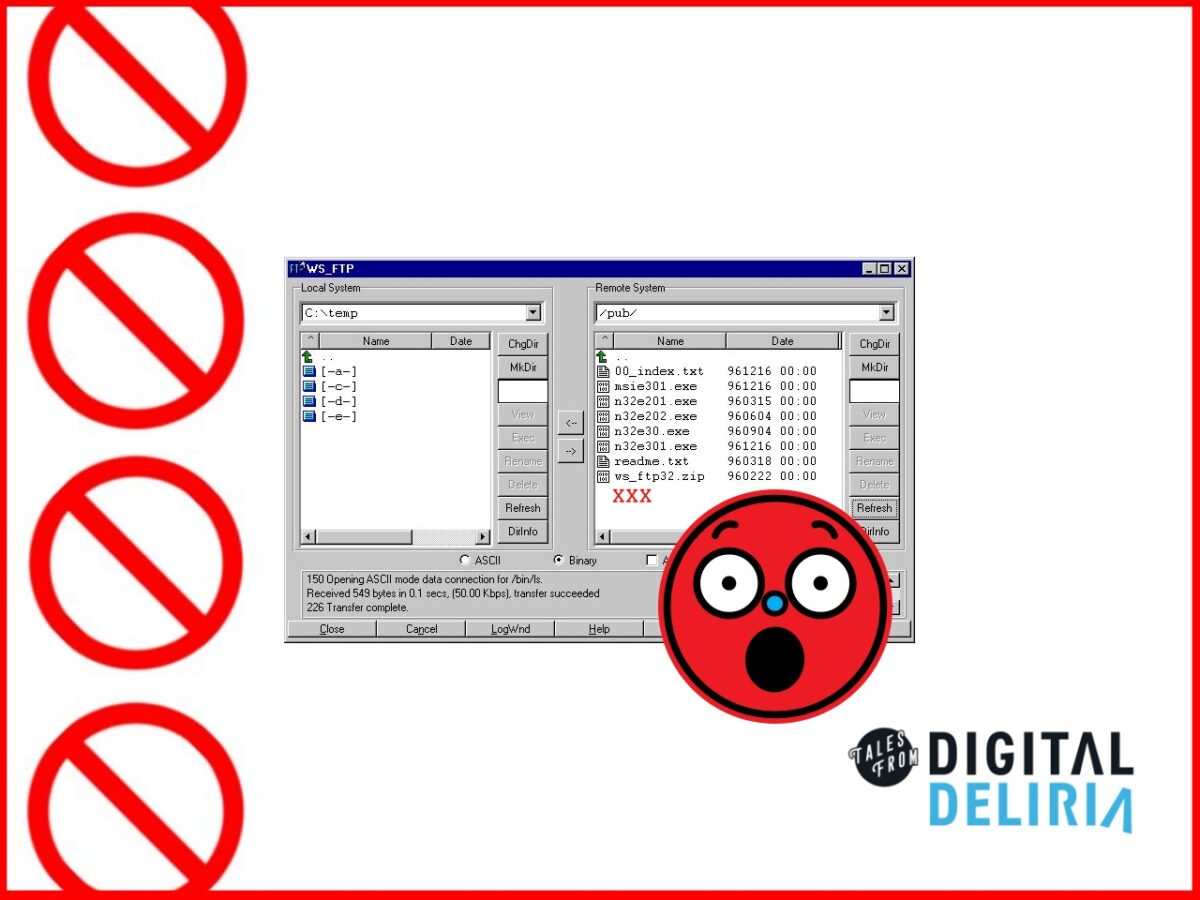Clients Shouldn’t Use FTP (And Other Lessons Learned)

“You better take that down.”
What?
What does that mean?
It’s hard to understand, but one thing is pretty clear from the tone of the voice on the other end of the line. You do not want to hear this voice at the start of your day.
Take what down? Take it down from where? Did the intern inadvertently launch the website too early?
Your mind races, until your drying mouth finally croaks: “What?”
“On the FTP site,” the simmering voice continues.
Now with a palpitating heart, you begin looking.
Before this story continues, allow me to share some context. Imagine your worst client. The belittling one. The one that sends 12-page faxes tearing your company up and down. The passive-aggressive, but mostly aggressive. The never-happy one. The one that could drive employees to take extreme measures to retain their own sanity.
Yeah that one. The Assistant of said client is our morning caller. And this morning is about to go bad. Really bad.
Looking around the FTP site… what, oh what, could be so objectionable to receive this urgent call? And what could be so inflammatory that there’s only dead silence on the other end of the line while I search?
And then… I saw it.
A folder. An otherwise innocuous entity. An omnipresent defacto of computing. But, it was the folder’s name… oh lordy mercy, the name.
I start to sweat and heat rises in my cheeks. I begin to wonder, why is our client in our FTP site? File Transfer Protocol: a tool used heavily by web-techie-folks to move files from one server to another. Why, oh why… and HOW did our client get in there? And how did they happen to find this insolently-named folder?
Well, maybe insolent is an understatement.
Look, I’m not a prude to late 90’s web developer shenanigans. Including swearing in the code, protected by the overall lack of web technical knowledge in the general population. In the early days, putting a dirty message in the client’s website code was a common bit of fun. No harm done: the client would never see or even know it was there. Only other web developers could get in on the “inside joke”, earning you brownie macho points. No wonder we have “code reviews” nowadays…
Anyway… this was no such hidden transgression, buried deep in website bowels. This folder name took a cheeky practice to a whole new level. And its presence on an FTP site made it much more discoverable.
Today, the client and I had perhaps encountered the first example of wholly digital passive-aggressive behavior. Surely a precursor to the web-world we live in now.
Well, Tell Me Already !
OK. So, one might ask: how could an employee so eloquently equate the client’s very name with a sex act, and put it on display via an FTP folder name? Through a few twists and switches of letters and syllables, that a person’s name could become an entirely new and novel term for oral sex?
Well — I’ll leave that to your imagination for the sake privacy for those involved, but I’m happy to share offline over an adult beverage. However as a hint, the client’s name was Richard (which of course has an unfortunate short form).
And I knew who did it, too. Gotta give the gal credit: she was a Creative, after all. But… Oh My.
She was the one you wouldn’t expect. The one who gave up a job at a “proper dot com” to come work with us rag-tags in our shabby, scrappy digital startup in an apartment. The one that everyone looked up to as a result. And the one who equally was distraught by her decision to enter into this world of ridiculous working conditions and clients with flame-throwing mouths.
“We will address that right away.” Click.
My next challenge had arrived: How do I tactfully yet forcefully convey to the Designer that this was not acceptable? That she’s been found out… not by her boss… but by the client himself?
I mustered all my grace, all my calm, all my stormy force. I called her name. (In that apartment, voices quite easily carried from my “office” squished next to the front door, to the “bull pen” in the adjacent family room.)
Enter said Designer into my desk area.
“Uh, you better take that down,” I said simply, pointing to the offensive file folder on my screen. “The client called me.” I put on my best stony face.
Within a second, I watched the color completely drain from her face. Followed by a sweeping beet red flush over her cheeks. A bead of sweat formed at her hairline. I’ve never since witnessed such a remarkable transformation in someone within seconds.
I felt horrible. I empathized with her. She was utterly ripped and ridiculed by this customer only late yesterday. We, the far-from-perfect, often deserved a firm critique. We were all trying to just “figure out” how to build this new thing called the web, and fails were common. But the level of abuse that she and others regularly endured from this client was unwarranted.
She turned away, acutely embarrassed, and within seconds the folder name returned to the client’s actual name.
Gotta admit now, the whole episode was pretty traumatic yet amusing… one of those “sear-into-brain-forever” moments.
What are the lessons learned?:
- Don’t swear in the code.
- Don’t mock your client’s name via objectionable FTP folder names.
- And, face the business challenge with professionalism and tact, even if others around you do not!
As always, I hope you enjoyed this and it brightened your day.
Please “like” if you did, share, and post your comments.
Don’t want to miss a future story? Be sure to sign up for our mailing list.
2 Replies to “Clients Shouldn’t Use FTP (And Other Lessons Learned)”
Comments are closed.

Carisa, I have to ask–you always tell us to “like” if we do, but I can’t figure out any way to “like.” I do read your posts and enjoy your stories of Ye Olden Daze of the Interwebz, and I would “like” if I could. What am I missing?
Thank you so much, Elizabeth, for reading and “liking”! 🙂 I’m so honored and appreciative! You’re right, there isn’t a button to “like” on this page, but if you follow us on social media (search @DigitalDeliria on Facebook or Instagram), you can “like” and also join in more conversation there 🙂 Thank you again!